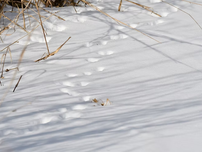top of page


Who goes there? Learn to track the tracks
Winter snow reveals signs of animal activity through fresh tracks. The best time to spot them is after a recent snowfall, especially overnight. Look in parks, yards, or along trails and observe the size, shape, and path of the prints. Clues may point to deer, squirrels, or ducks. Even without snow, tracks can be found in mud or dust. Following footprints and asking questions helps uncover which animals or people have passed through.


'Tis the season to embrace the dark
-The winter solstice is the shortest day of the year and marks when days begin to grow longer. People have celebrated it for thousands of years with traditions that honor both darkness and light. Try stargazing, flashlight games, or a cozy bonfire. Write down worries to burn in the fire and set intentions for the new year. Whether exploring the night or enjoying candlelight indoors, find joy in both the dark and the light of winter.


Feed the birds this winter with homemade suet
Some birds, like juncos, migrate to Illinois for winter. Birds stay warm with extra feathers and need high-fat, high-protein food like suet. You can help by making your own suet feeders with lard, peanut butter, seeds, oats, cornmeal and fruit. Mold the mix into fun shapes and hang it outside. Watch for hungry birds all winter, but remember to remove suet feeders in spring when temperatures warm up.


Let the prairies inspire your next artistic creation
Illinois prairies are full of color, life and inspiration. Visit preserves like Lockport Prairie or Midewin to see tall grasses, wildflowers and wildlife. Paint outdoors or use photos and sketches to create at home. Just be respectful of nature, clean up when done and let the prairie spark your creativity.


How does your garden grow? As a family
Gardening with native plants is low-maintenance, supports pollinators, and offers great learning for kids. It teaches environmental stewardship, supports physical development, and brings families closer. Start small, use kid-sized tools, pick quick-blooming plants, and involve kids in care. Track progress with a garden journal. Native gardening is a fun, hands-on way to connect kids with nature.


Standing tall: Be a tree on your next trip outside
Pretend to be a tree. Stand tall, spread your arms like branches, and plant your feet like roots. Close your eyes and imagine connecting with the earth and nearby trees. Feel the wind, the sun, and the world around you. Trees communicate through touch and underground networks—try it with a friend. After a few still moments, return to your human form. Try this fun nature exercise in a park, forest, or backyard.


Let's count bugs! What an insect census can tell us
An insect census helps scientists study biodiversity and habitat health. Insects are vital for pollination and the food chain. You can join by watching insects near plants, recording what you see, and sharing your data. Use tools like a timer, paper, and a camera. Even if you’re not an expert, your observations help real scientists. Just remember to be gentle and return any insects you catch.


Head outside this summer for after-Dark scavenger hunt
Try a nighttime scavenger hunt to discover things you can only see or hear after dark like stars, bats, fireflies, glowing animal eyes and insect calls. Turn it into a team challenge with flashlights and silly selfies. Explore forest preserves or camp overnight for even more fun under the stars.
bottom of page